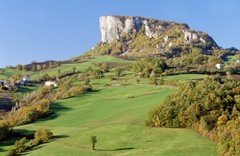Municipality of Castelnovo ne' Monti.
Pietra di Bismantova
Currently an integral part of the National Park of the Tuscan-Emilian Apennines, is the so-called Pietra di Bismantova, a rocky spur whose unmistakable massive, table-top outline stands out clearly from the Apennine chain. This natural balcony, which rises 1,000 metres above sea level, is formed from dune limestone, marlstone and sandstone going back to the lower Miocene, that is to say, around twenty million years ago. The Pietra owes its current appearance to the progressive action of atmospheric agents, telluric disturbances and climate changes. The finding of sharks’ teeth and seashells indicates the local presence of marine deposits. Written records speak of an ancient castle that once stood on the eastern edge of the Pietra’s summit – an unstable border area after the end of the Roman Empire, and the site of struggles between Byzantine and Lombard armies, who indulged in repeated attacks to gain control over it. These battles, along with successive landslides over the centuries have left us only a few fragments of the castle, which the silent vegetation has by now almost completely buried.
But these places were already inhabited in prehistoric times, as witnessed by a necropolis of considerable dimensions on a level ledge halfway up the slope, known as Campo Pianelli, which came to light in the XIX century thanks to a priest, Gaetano Chierici. Scholars have dated it to the so-called proto-Villanovan period of the late Bronze Age, around one thousand BC. The finds – brooches, bronze rings, amber or glass beads, buckles and other everyday objects of the deceased – are now kept at the Civic Museums in Reggio Emilia. Nowadays this singular site has become very popular and receives many visits. It is recommended to make excursions on foot, following the enchanting paths through the undergrowth, particularly the classic one which in about half an hour leads from the base of the mountain to the plateau at the summit where a fantastic 360° panorama can be enjoyed. Another delightful path circumnavigates the rocky monolith taking in significant environmental and cultural points of interest.
Not to be missed is a charming, inviting little church, an authentic place of the spirit, just recently raised to the rank of diocesan sanctuary, which nestles snugly in a gorge at the foot of the overhanging southern cliff. This building, which was transformed from a primitive hermit-like chapel into an oratory in the late Middle Ages, has undergone various alterations over the centuries, and now presents worshippers and visitors alike with a neo-Romanesque look after the latest, radical restoration of around 60 years ago. Inside are some fourteenth- and fifteenth-century frescoes.
But to speak of Pietra di Bismantova also means, at least for the last few decades, speaking of climbing, a discipline practised very intensely here by the many fans who enthusiastically gather here, some from far off. Especially at weekends, from the piazza below it is not difficult to spot mountaineers clinging to the rocky walls on their way up, taking advantage of the “rock gymnasium” that this singular natural protuberance offers.
And finally, a dutiful literary reference. It is believed that the “divine poet”, Dante Alighieri, passed near the Pietra di Bismantova in 1306, during a journey from the Lunigiana to Verona. This event is recorded in a passage of the Divine Comedy, in the IV canto of Purgatory in these verses: “who journeys, or to Noli low descends, or mounts Bismantova’s heights, must use his feet, but here a man had need to fly”.
However, apart from Bismantova there are other sites that represented and continue to represent the history of Castelnovo’s territory, as well as its indissoluble link with Matilda’s times. Such as, for example, the Parish Church of Campiliola, sitting on a hill to the north overlooking the village, clearly visible from the urban stretch of the Statale 63 road, a major artery that runs through the village. This church unquestionably dates to before the X century, while in the XIII century contemporary documents mention it as the largest and most important of the diocese of Reggio Emilia. It underwent major rebuilding and expansion in the XVII century, which gave the church and the adjacent rectory their current appearance with a courtyard-like structure that is very fascinating from an architectural point of view.
It has been said that on the summit of Bismantova there was once an important castle, but in Matilda’s times this building already lay in ruins, according to the records: consequently the XI century would seem a likely date for the construction of the oldest part of the Castelnovo village, lying at the foot of one of the three surrounding mountains, now covered in conifers. Moreover, to tighten control over the territory which already contained a dense network of castles and guard posts, it was the Canossa family who built a new castle on the summit of the above-mentioned mountain. On the site, where only a part of a square tower remains visible, archaeological excavations have been carried out in recent years which are bringing to light other rooms and interiors, as confirmation of extended use for many centuries, right up to the Este era.
Instead from Matilda’s times are some hamlets which now lie within the Municipality of Castelnovo: Felina, where a circular tower still exists, nicknamed by the locals “The Salami”, Maillo and Gombio, where the records mention another two castles, and where there are still some major tower houses and other buildings of great architectural interest.
